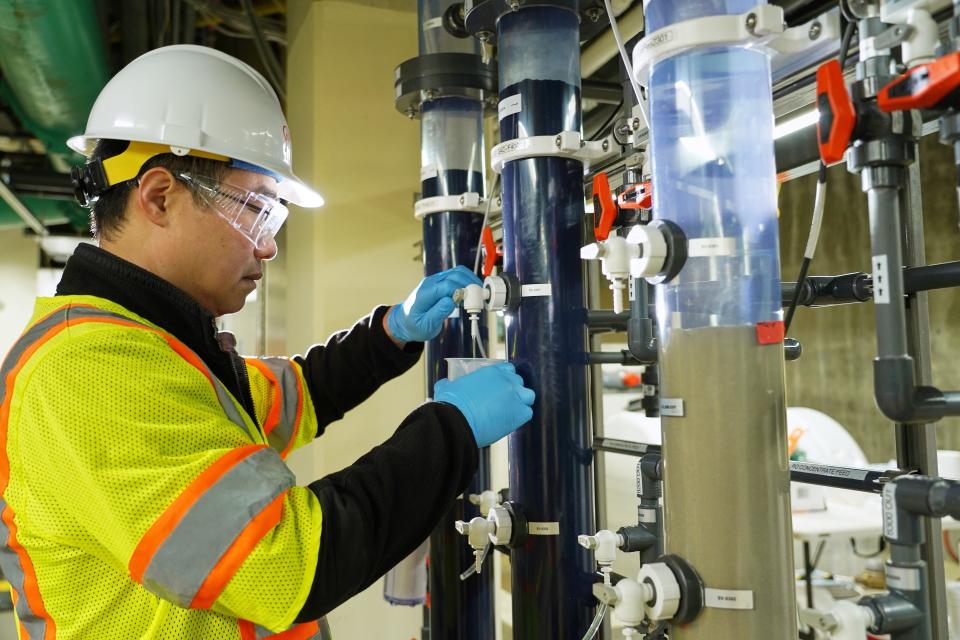Hundreds of drinking water systems exceed new PFAS standards. It could grow to thousands.
After more than a year of collecting test results for toxic “forever chemicals,” the Environmental Protection Agency says almost 300 of America’s public drinking water systems – including some that serve hundreds of thousands of people – exceeded newly established annual limits.
That means these water utilities may need to start filtering their water or find new sources to comply with new rules limiting PFAS, or per-and polyfluoroalkyl substances. PFAS are nearly indestructible chemicals that have been shown to build up in human bodies, increasing the risk for certain types of cancer and other serious health complications.
USA TODAY recreated the EPA’s analysis and found public systems in Fort Worth, Texas; Fresno, California; Pensacola, Florida; and Augusta, Georgia, were among the hundreds whose sample averages landed above the new annual limits.
That number is bound to grow over the next two years as more water utilities submit their test results. Last month, the EPA estimated that one in 10 – or more than 6,000 – systems may eventually need to take some sort of corrective action to rid their water of PFAS.
Map: Where water systems reported PFAS contamination
This map shows water systems included in the EPA’s PFAS testing records, as of May 16, 2024. It’s based on boundaries developed by SimpleLab, a water-testing company. Points represent systems where the exact boundaries are not available. Enter an address to locate the nearest water systems. Then click on a system to review its PFAS measurements. Don't see a map? Click here.
Thousands of water systems have been testing for more than two dozen types of these compounds since January 2023 in the EPA’s most widescale effort ever to track PFAS’ spread across the country.
Most public systems serving at least 3,300 customers must sample their drinking water either semiannually or quarterly throughout a single year and submit the results to the EPA.
These results represent single point-in-time measurements of PFAS, and the EPA wouldn’t require water systems to make changes unless a sample site’s running annual average surpasses the new limits. Plus, the agency is giving water systems five years to treat their water before it will enforce the new rule.
Almost 800 drinking water systems across the United States have recently measured PFAS at or above the newly established limits at least once, according to a USA TODAY analysis of data the EPA released last week.
Water from these systems eventually pours out of the faucets of approximately 47 million people.
Altogether, the EPA data now includes PFAS test results from 4,750 water systems. Over 1,000 were included for the first time in last week’s update, and they do show one bright spot: Many of the largest, newly added water systems haven’t detected any PFAS yet, including Los Angeles; Chicago; Tucson, Arizona; Boston; and Portland, Oregon.
How are water utilities getting PFAS out of their water?
Testing in Fort Worth, which relies on surface water drawn from a nearby lake, shows yearly averages for three separate PFAS chemicals topped the new limits at two of the city’s water treatment plants, according to USA TODAY’s analysis.
Mary Gugliuzza, spokesperson for Fort Worth Water, said the utility took action last summer with a PFAS treatability study “as soon as we were seeing numbers above” the then-proposed limits. She said they plan to go before the City Council as soon as next month to get a contract to begin designing a treatment process that uses granular activated carbon.
“We have been quite upfront that this is going to be expensive. I don't have an exact price tag for you,” Gugliuzza said. “We're going to seek any federal assistance that's out there to try and reduce the burden on our ratepayers. But we also know that there's not enough money for everybody out there, and a lot of people are going to be seeking this.”
Sample results from Emerald Coast Utilities Authority in Pensacola show the yearly average from a dozen wells topped the new limits – as much as six times over the limit in one well’s results for PFOS, one of the most studied and common PFAS chemicals.
"We're continuing to pursue an initiative that we began many years ago to add granular activated carbon filtration to all of those wells that have any detections of PFAS chemicals in them," said Bruce Woody, executive director of the authority. "We will get that completed well within the allotted time period."
Recent budget documents from the water system show plans to invest $2 million into a granular activated carbon treatment system at one of its wells. In addition, prior reporting from the Pensacola News Journal, a member of the USA TODAY Network, shows the utility sued manufacturers of firefighting foams, claiming that toxins from the foams seeped into the groundwater around Pensacola’s airport and Naval air station.
Even before the EPA finalized its new limits, the Water Authority of Western Nassau County on Long Island had been installing PFAS treatment on 11 contaminated wells to comply with New York state regulations that went into effect in 2020, according to Superintendent Michael Tierney. Now, with the stricter federal standard, he said there are four additional wells where treatment will need to be installed.
“I've been doing this for 44 years,” Tierney said. “I've never seen a flurry of required regulatory demands such as this.”
The authority is pivoting its efforts to meet not only state-specific standards but also the more stringent federal ones by revisiting and retrofitting previous projects, Tierney added.
“I’m going to have to rip up what I just put in, in many regards,” Tierney said. “So that hurts, that really hurts. If we knew ahead of time and could have planned, it would have been much easier and much more cost-effective.”

As the largest private operator of water services in the U.S., Veolia Water has a few systems where yearly averages topped the new limits, according to USA TODAY’s analysis. EPA data show a water treatment plant at its Delaware location in Wilmington averaged nearly five times over the new limit for PFOA, another of the most studied “forever chemicals.”
The company has been proactive about addressing PFAS in several states for the past few years, and construction is underway for a new treatment facility in Delaware, said Michael Bard, manager of communications and community relations at Veolia North America. The facility will house 42 carbon filters that treat PFAS down to nondetectable levels in a building as large as a regulation-size hockey rink.
The facility is expected to be fully operational by early 2025, and Veolia’s Delaware operations anticipate no challenges in complying with the EPA’s rules by 2029, Bard said.

“Given the regulations, we know that a lot of water systems are probably going to be looking for similar technologies,” Bard said. “We were very proactive in the procurement process and in thinking about supply chains, sourcing and securing those materials.”
The costs associated with the PFAS treatment project will likely be recovered by raising customer rates, Bard said.
“The cost of doing nothing is going to be far worse than the cost of doing something about this,” said Adam Lisberg, senior vice president of communications in Veolia’s municipal water division. “Nobody likes to pay more, but people want to know that they can have confidence in their water.”
This article originally appeared on USA TODAY: Many of America's drinking water systems have a major (PFAS) problem

